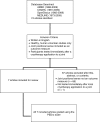Cryotherapy and joint position sense in healthy participants: a systematic review
- PMID: 20446845
- PMCID: PMC2865970
- DOI: 10.4085/1062-6050-45.3.306
Cryotherapy and joint position sense in healthy participants: a systematic review
Abstract
Objective: To (1) search the English-language literature for original research addressing the effect of cryotherapy on joint position sense (JPS) and (2) make recommendations regarding how soon healthy athletes can safely return to participation after cryotherapy.
Data sources: We performed an exhaustive search for original research using the AMED, CINAHL, MEDLINE, and SportDiscus databases from 1973 to 2009 to gather information on cryotherapy and JPS. Key words used were cryotherapy and proprioception, cryotherapy and joint position sense, cryotherapy, and proprioception.
Study selection: The inclusion criteria were (1) the literature was written in English, (2) participants were human, (3) an outcome measure included JPS, (4) participants were healthy, and (5) participants were tested immediately after a cryotherapy application to a joint.
Data extraction: The means and SDs of the JPS outcome measures were extracted and used to estimate the effect size (Cohen d) and associated 95% confidence intervals for comparisons of JPS before and after a cryotherapy treatment. The numbers, ages, and sexes of participants in all 7 selected studies were also extracted.
Data synthesis: The JPS was assessed in 3 joints: ankle (n = 2), knee (n = 3), and shoulder (n = 2). The average effect size for the 7 included studies was modest, with effect sizes ranging from -0.08 to 1.17, with a positive number representing an increase in JPS error. The average methodologic score of the included studies was 5.4/10 (range, 5-6) on the Physiotherapy Evidence Database scale.
Conclusions: Limited and equivocal evidence is available to address the effect of cryotherapy on proprioception in the form of JPS. Until further evidence is provided, clinicians should be cautious when returning individuals to tasks requiring components of proprioceptive input immediately after a cryotherapy treatment.
Figures




Similar articles
-
Running shoes for preventing lower limb running injuries in adults.Cochrane Database Syst Rev. 2022 Aug 22;8(8):CD013368. doi: 10.1002/14651858.CD013368.pub2. Cochrane Database Syst Rev. 2022. PMID: 35993829 Free PMC article.
-
Health professionals' experience of teamwork education in acute hospital settings: a systematic review of qualitative literature.JBI Database System Rev Implement Rep. 2016 Apr;14(4):96-137. doi: 10.11124/JBISRIR-2016-1843. JBI Database System Rev Implement Rep. 2016. PMID: 27532314
-
Cryotherapy following total knee replacement.Cochrane Database Syst Rev. 2023 Sep 14;9(9):CD007911. doi: 10.1002/14651858.CD007911.pub3. Cochrane Database Syst Rev. 2023. PMID: 37706609 Free PMC article.
-
Eliciting adverse effects data from participants in clinical trials.Cochrane Database Syst Rev. 2018 Jan 16;1(1):MR000039. doi: 10.1002/14651858.MR000039.pub2. Cochrane Database Syst Rev. 2018. PMID: 29372930 Free PMC article.
-
Systemic pharmacological treatments for chronic plaque psoriasis: a network meta-analysis.Cochrane Database Syst Rev. 2021 Apr 19;4(4):CD011535. doi: 10.1002/14651858.CD011535.pub4. Cochrane Database Syst Rev. 2021. Update in: Cochrane Database Syst Rev. 2022 May 23;5:CD011535. doi: 10.1002/14651858.CD011535.pub5. PMID: 33871055 Free PMC article. Updated.
Cited by
-
Dynamic Postural-Stability Deficits After Cryotherapy to the Ankle Joint.J Athl Train. 2015 Sep;50(9):893-904. doi: 10.4085/1062-6050-50.7.07. Epub 2015 Aug 18. J Athl Train. 2015. PMID: 26285088 Free PMC article.
-
Effect of quadriceps and hamstrings muscle cooling on standing balance in healthy young men.J Musculoskelet Neuronal Interact. 2017 Sep 1;17(3):176-182. J Musculoskelet Neuronal Interact. 2017. PMID: 28860419 Free PMC article. Clinical Trial.
-
The Effect of Ice on Shoulder Proprioception in Badminton Athletes.Eur J Investig Health Psychol Educ. 2023 Mar 21;13(3):671-683. doi: 10.3390/ejihpe13030051. Eur J Investig Health Psychol Educ. 2023. PMID: 36975403 Free PMC article.
-
Muscle Reaction Time During a Simulated Lateral Ankle Sprain After Wet-Ice Application or Cold-Water Immersion.J Athl Train. 2015 Jul;50(7):697-703. doi: 10.4085/1062-6050-50.4.05. Epub 2015 Jun 11. J Athl Train. 2015. PMID: 26067429 Free PMC article. Clinical Trial.
-
Should athletes return to sport after applying ice? A systematic review of the effect of local cooling on functional performance.Sports Med. 2012 Jan 1;42(1):69-87. doi: 10.2165/11595970-000000000-00000. Sports Med. 2012. PMID: 22121908
References
-
- Swenson C., Sward L., Karlsson J. Cryotherapy in sports medicine. Scand J Med Sci Sport. 1996;6(4):193–200. - PubMed
-
- Knight K. L. Cryotherapy in Sport Injury Management. Champaign, IL: Human Kinetics; 1995. pp. 9–11.
-
- Vaile J., Halson S., Gill N., Dawson B. Effect of hydrotherapy on the signs and symptoms of delayed onset muscle soreness. Eur J Appl Physiol. 2008;102(4):447–455. - PubMed
-
- Bleakley C., McDonough S., MacAuley D. The use of ice in the treatment of acute soft-tissue injury: a systematic review of randomized controlled trials. Am J Sports Med. 2004;32(1):251–261. - PubMed
-
- Muaidi Q. I., Nicholson L. L., Refshauge K. M. Proprioceptive acuity in active rotation movements in healthy knees. Arch Phys Med Rehabil. 2007;89(2):371–376. - PubMed
Publication types
MeSH terms
LinkOut - more resources
Full Text Sources
Medical

